

In
1932 he made a portrait of S. Jassa Singh Ramgarhia, which fetched him a first
prize at the Ramgarhia Federation Conference at Kharagpur.
A portrait of Banda
Bahadur in a 'warrior's pose', which sold in thousands was very well acclaimed
by the public. He bagged gold medals and high awards at exhibitions held at Calcutta,
Kharagpur, Bombay, Trivandrum, Delhi etc. He won quite a few gold medals, plus
silver medals and awards in money.

An exceptional painting of Guru Nanak was bought by nearly 500 Americans, who were very much impressed with the artist's flare of the brush. S. Sawarn Singh, the Home Minister, presented S. Sohan Singh, with a 'Saropa' at the Maharaja Ranjit Singh Company Bagh at Amritsar in a ceremony inaugurated by the SGPC.
Mulk
Raj Anand and Principal Teja Singh have paid glowing tributes to this talented
artist.
Art students, who want to obtain degrees in art, have been flocking
at his studio to obtain special knowledge on art
Sohan Singh is a very mild natured man and a very humble person. His art can be seen in periodicals like Preet Lari, Ajit, Veer Bharat, Shere Bharat and many other magazines. His designs of calendars, labels and posters are a masterpiece, unequalled by any other artist.
At Chandigarh in 1970 he was acclaimed the Master Artist of the year, and the same year at Ludhiana he received a prestigious award from the Ramgarhia Silver Jubilee Conference.
His studio at the Braham Buta Market, Amritsar is a shrine for young and upcoming artists.

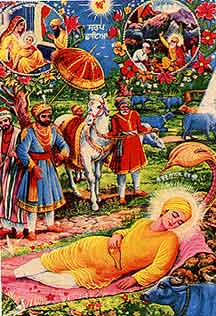
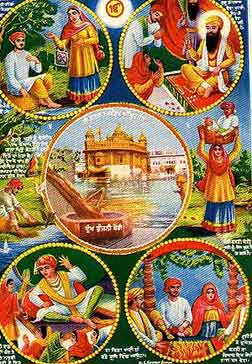


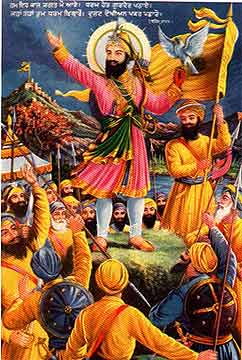

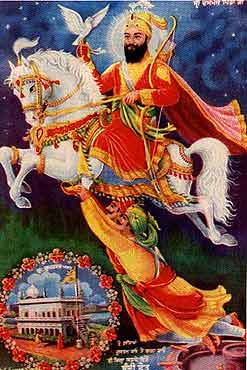
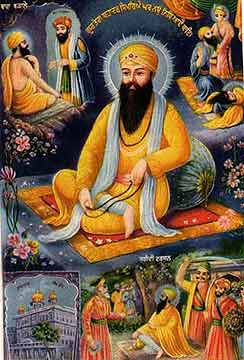
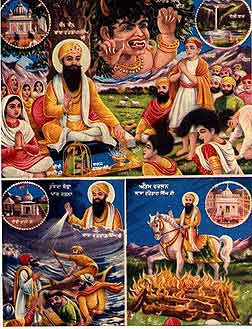
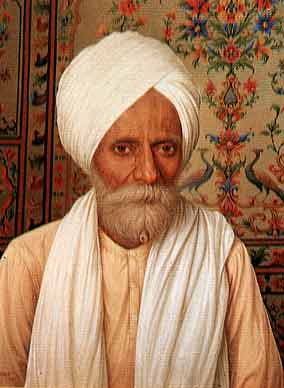
Bhai Gian Singh (1883-1953), a Naqqash or a Fresco-Painter
was born in the city of Amritsar in 1883. His father Taba Singh was a comb-maker
by profession, supplemented his meagre income by dispensing ayurvedic medicines
in his spare time. At the age of five, Gian Singh was sent to school run by Giani
Thakur Singh, who later rose into prominence as a Sikh missionary and scholar
Giam Thakur Singh's influence on him was everlasting.
After he had passed
his primary school, Gian Singh was apprenticed to Nihal Singh Naqqash, a third
generation descendant of Bhal Kehar Singh Naqqash, who enjoyed court patronage
under Maharaja Ranjlt Singh. Gian Singh served his apprenticeship for 14 long
years until the death of his mentor in 1905 He brought to his passion for drawing
unusual powers of observation and concentration He made rapid progress in his
art and soon began to collaborate with Jawahar Singh Naqqash, a brother of his
erstwhile teacher, in working on ornamental designs in the Golden Temple.
Gian Singh's fame will rest principally on his fresco-painting on the walls of
the Golden Temple. The art of fresco-painting consists in transferring the outline
(Khaka) of a design on wet plaster and then filling the outline with appropriate
colours before the plaster dries up. The basic colours thus established are worked
with requisite details and light and shade achieved with dots and streaks. The
colours used are indigenously prepared red ochre from hiramchi yellow ochre from
gulzard, emerald green from sang-e-sabz, lamp black from burnt coconut, ultra
marine from lajvard and white from burnt marble.
While much of Gian Singh's
work on the outer walls of the domed structure, on the topmost storey, stands
partially erased by wind and rain, that on its inner walls yet survives in its
original freshness. One dehin executed by him in the sanctum on the first floor,
just above Har ki Pauri, bears testimony to his inimitable workmanship. Dehin,
the most fascinating item of fresco-painting was Gian Singh's forte. It is an
imaginative ensemble of forms taken by the artist from animal or vegetable life,
so curiously intertwined as to present a composite and organized whole Structurally,
dehin has three parts- pedestal, a vase poised on the pedestal and a bouquet of
flowers or a floral bush called jhar. On the pedestal are depicted birds or animals
in various dramatic postures in clasp, in combat or one chasing the other. These
figures are often intertwined with creepers.
The other items of note in fresco-painting
are floral "square " ( murraba) and "rectangle" (tilli). These
are used in wall, floor or ceiling decoration. The square usually consists of
a fine setting of flowers, leaves, creepers or bushes within a flowery border
with handsomely patterned corners. A typical example of a square done by Gian
Singh is the one called Aquatic Harmony. It takes for its motif a number of fish
encircling a tortoise, with others frolicking around the first set in a circular
rhythm.
Gian Singh introduced a number of innovations in the art of fresco
painting. His predecessors in the Sikh school of art depicted gods and goddesses
in the body of the pedestal in the manner of their Persian or Mughal forerunners.
But Gian Singh replaced these motifs with those of "grapples" (pakran)
of animals, birds, flowers, creepers, etc. He also painted historical Sikh shrines
on the body of the vase formerly left blank in addition to this, he brought shade
work to a high standard of perfection and gave a poetic touch to his compositions
by making them rhythmically balanced and elegant. The colours he used were always
bright and attractive.
Apart from fresco painting Gian Singh tried his hand
at several allied arts such as (gach) stuccowork, (jarathari) mosaic work and
(tukri) cut-glass work. He was an expert in gach work which consists in carving
embossed designs on partially wet layers of plaster of Paris and afterwards, when
completely dry, covering it with gold leaves with an undercoat of varnish. Verses
from the Japu ji have been rendered in this style under the arches leading to
the sanctum in the Golden Temple. Another type of work popularly known as tukri
work, much in vogue in Mughal days, consists in setting pieces of glass, gold
leaves or precious stones in gach work in artistic patterns. The twin work on
the inside of the dome in the central sanctum of the Golden Temple executed in
its entirety by Gian Singh, bears witness to his sense of design and his patience
and assiduity.
Gian Singh not only prepared designs for Jaratkari (mosaic)
work in marble to be executed by craftsmen from Delhi and Rajasthan, but also
selected stones of appropriate colour and grain to be laid in the marble. The
mosaic designs were based on colourful representations of flora and fauna or on
themes picked from Hindu mythology.
Gian Singh was a master of free-hand drawing.
His pencil kept pace with the abundance of designs and ideas which flowed from
his fertile mind as some of his published works like Nikashi Darpan, Vishkarma
Darpan, Nikashi Art Sikhhya and Taj-e-zargari, indicate.
In the Nikashi Darpan
(1924), he has drawn stylised forms of various flowers side by side with their
natural forms, showing how the latter could be improved upon for the purpose of
adjustment in a design. It also contains line work studies of birds and animals,
different limbs and organs of the human body, border designs in rectangular, square,
half patterns, allover patterns and vase stands composed of rhythmically intertwined
animal, bird and plant forms. The Vishkarma Darpan (1926) is a profusely illustrated
manual of decorative, architectural and furniture designs. The Taj-e-Zargari (Vol.
1 1920, and Vol II, 1930) contains 1539 designs of Indian ornaments. The Nikashi
Art Sikhya (1942) contains scores of sketches designed to initiate a beginner
into the intricacies of drawing.
While toiling at larger works, Gian Singh
found time for painting easel pictures in which he could freely indulge his humour.
Some of his canvases are notable for their originality of conception and workmanship.
His painting Types of Irreligious, which illustrates a well-known couplet of Kablr,
is a biting satire on charlatans who dupe the naive and the gullible in the name
of religion. The Eternal Strife, based on a mythological theme, represents the
forces of Good (suras) locked in mortal combat with those of Evil (asuras) . The
Elephant Fight allegorises Maya and its victims. It depicts two male elephants
(victims) contending fiercely for the prize - Maya in the form of a female elephant
who, standing at a distance, contemplates the fight with sadistic mirth.
In
appreciation of Gian Singh's exquisite work in the Golden Temple, he was presented,
in 1949, with a robe of honour by the Shiromani Gurdwara Parbandhak Committee.
During his apprenticeship, Gian Singh had prepared a set of paintings on the Ten
Sikh Gurus which was printed in Germany. It became very popular.
Gian Singh
died in 1953. Another famous Amritsar artist, G.S.Sohan Singh, was his son. His
eldest son, Sundar Singh, was martyred in the Jallianvala Bagh Firing.
Excerpts
taken from
"The Encyclopedia of Sikhism" edited by Harbans Singh.
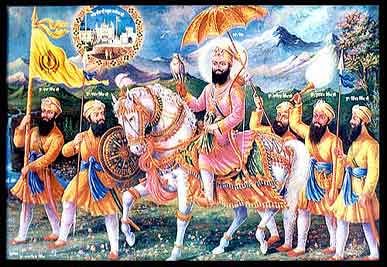
A painting of Guru Gobind Singh with Panj Piaras by GS Sohan Singh